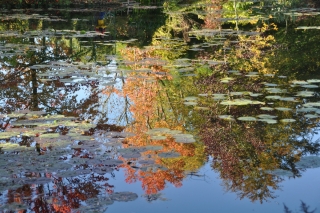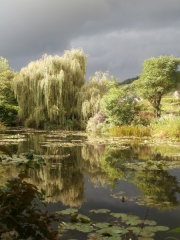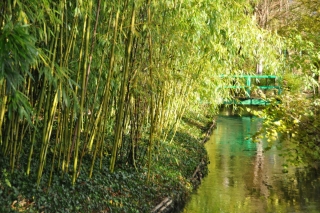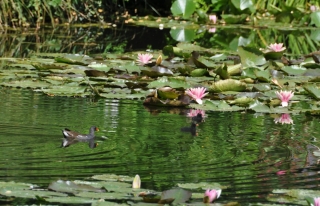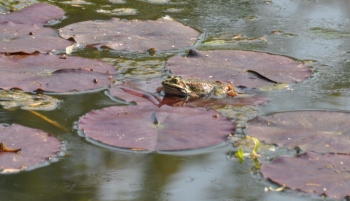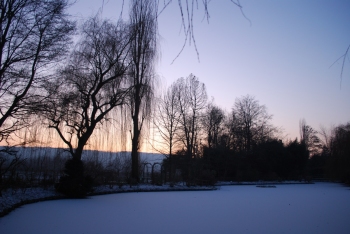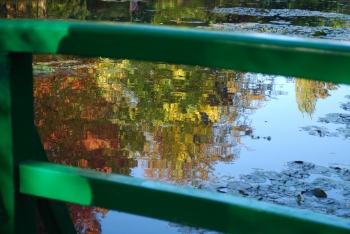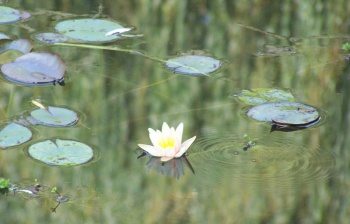February 19, 2015
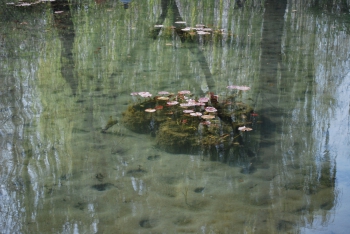
As long as the water is still cold, the algaes don’t feel like growing. They wait patiently for better times to come.
In March, the water of Monet’s pond is so clear that the bottom looks close, offering shamelessly all its details to the view.
The uneven surface of the layer of mud resembles the moon, with mysterious craters everywhere. The planters of water lilies pop up in this desert like a lunar buggy.
The brave first leaves have made their way through the water to reach the surface, looking for sun and energy. They are still purple but will soon turn green.
In back light, when the weather is fine, innumerable stars twinckle on the surface where the light kisses the water.
This crystal clear water is the show awaiting the first Giverny visitors. In April, days get longer, warmer, and the inviting sunbeams awake grass, flowers, trees and algaes alike.
Some years, the water looses its transparency and gets almost milky, to my delight, because I like the way it absorbs the colors, I find it lovely. After a while the water clears up again.
Posted in Giverny, Monet's House, Water-Garden No Comments »
November 24, 2014
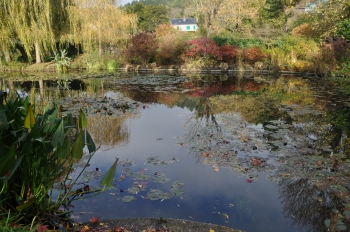
Fall atmosphere in Monet’s gardens at Giverny.
The picture was taken from the steps of the dock next to the water lily pond.
On the left, the green leaves of pontederias.
The red shrub on the opposite bank is a Japanese maple.
In the distance appears the pink house with green shutters, Monet’s home for 43 years.
On the right, through the branches, the third studio where Monet painted his biggest water lilies panels.
Posted in Giverny, Claude Monet, Water-Garden No Comments »
November 9, 2013
On the 30th of October, the perfectly serene pool in Claude Monet’s garden offers a mirror view of the world around.
Blue sky and turning trees create a bold contrast between the still floating water lily pads.
(Click on the picture to enlarge).
Posted in Giverny, Water-Garden 1 Comment »
September 18, 2013
An unusual light on Monet’s water lily pond, while big dark clouds are loaming ahead… Just time enough to walk around the pound, and the drops will start to fall on the surface of the pool in hundreds of little circles.
Posted in Giverny, Water-Garden 2 Comments »
October 27, 2012
Claude Monet planted a beautiful bamboo grove in his water garden at Giverny.
Bamboos are ever green. This picture was taken on the 1st of November, the very last day of the season, and even on such a late date bamboos were as pretty as ever.
Bamboos are not native to France. The golden bamboos that Monet chose look very tall and exotic in Normandy.
Monet liked growing giant plants and Japanese plants, and bamboos were both at the same time.
As a clever gardener, the painter chose the best location for them: on an island of his water garden, where they would get enough water, and where the invasive roots would be contained by the stream.
He never painted them, but certainly liked the contrast their shade produces with the pond, that is open and full of light.
After Monet passed away, the garden was left without much tending for long years. But the bamboos have survived, because they regenerate spontaneously, making new shoots every year.
During the decades when Monet’s house was left uninhabited, the garden became the playground of the children of Giverny. One of their favorite games was playing Tarzan in Monet’s bamboo grove. For them, it looked like a rain forest.
Posted in Water-Garden, Flower No Comments »
July 26, 2012
Here are the moor hens living on Claude Monet’s pond at Giverny.
Every year, they nest on the island in the middle of the pond, or in the shrubs around. After a few weeks, they appear on the water with their adorable little chicks, five of them generally.
They are so sweet, light enough to walk on the lily pads. Both parents take care of them. But it won’t help.
Because we are human beings with a memory, we know what’s going to happen next: the ducklings will end in the belly of the pike living in the pond. This is the cruel story that repeats every year.
But because they are moor hens, and have not much space for brains in their head, they forget every year and keep nesting on the same location.
This afternoon two of the smalls only were left.
Posted in Water-Garden, About Nature No Comments »
May 20, 2012
This is Monet’s pond at Giverny seen from the Japanese Bridge in May, when the wisterias are in bloom.
The water lily pads float like islands on the surface. No flowers yet.
Short before closing time, visitors are few. The late afternoon sunshine enlightens the trees on the eastern side of the pool. Silence falls on the garden. The scent of the flowers is in the air.
Posted in Giverny, Water-Garden No Comments »
April 21, 2012
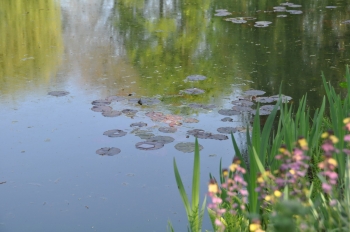 I have eventually gathered my favorite pictures of Giverny into a photo gallery.
I have eventually gathered my favorite pictures of Giverny into a photo gallery.
Season after season, Monet’s water garden and flower garden change a lot.
I like early morning atmospheres as well as rainy days, bright sunshine or sunset. I like the snow white garden. I like roses and nympheas. I like the colors of autumn, the stunning reflections on the pond.
I hope you will like them too.
If you’d like painting after my pictures, please feel free. I would be happy to see your work.
Posted in Monet's flower garden, Water-Garden, Flower 6 Comments »
March 23, 2012
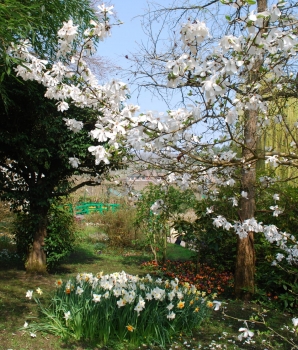 This is what you can expect if you are visiting Giverny in Early April. The white and pink magnolias are in blossom. Very soon, their flowers will fall on the lawns, creating a white circle at the foot of the trees.
This is what you can expect if you are visiting Giverny in Early April. The white and pink magnolias are in blossom. Very soon, their flowers will fall on the lawns, creating a white circle at the foot of the trees.
The pimples of weeping willows have burst, long branches of fresh green leaves hang over the pond, reflecting in endless verticals.
Patches of yellow or white daffodils illuminate the spring grass and diffuse a fabulous scent.
Monet’s pond, where only a few water lily pads announce the future splendour of Summer, is stiller than ever, and the atmosphere very peaceful.
All the benches and bridges have been repainted a bright green. They look inviting.
And birds sing like mads, offering the perfect voice track for a quiet and serene visit of Giverny.
Posted in Monet's flower garden, Water-Garden 2 Comments »
February 23, 2012
This is what is needed at Giverny to keep Monet’s pond as clean as a mirror:
– a flat boat copied from Monet’s, very common in his times,
– a big garbage can,
– a carp net,
– thick gloves to protect your hands.
Equipped with these very simple tools, the gardener is ready for the constant battle he has to fight.
The battle field is the surface, and the invaders are of different kinds. The main body of the army is made out of dried leaves and seeds. Drown bugs must go, too.
Alone against the ennemy that is continuously renewed, the gardener must be a super heroe. He needs a good balance, a strong back and strong arms to fish the dirt and take it out, leaf after leaf. Good spirits are essential too. Patience and perseverance.
No wonder the algaes and leaves fishing gardener is the star of the pond, photographed millions of times by the visitors of Giverny.
Posted in Water-Garden No Comments »
April 30, 2011
Frogs are very loud these days at Giverny.
The rest of the year, they are rather shy, and you rarely see them. But in Spring, especially in April, they croak.
The big bubbles the toad inflate on their cheeks betray them, although their color matches perfectly the water lilly pad they are seated on.
Their choir is not continuous. It sounds all of a sudden in the silent air. One frog starts, and quickly all the other ones reply, louder and louder. After a minute or two, they stop briskly.
I suppose they believe they sung harmoniously and are waiting for the applause of the visitors walking around Claude Monet’s pond.
Posted in Water-Garden, About Nature No Comments »
January 14, 2010
It was a dream come true for me to enter Monet’s garden at sunset to take pictures of the dusk.
Cold Winter days finish in a symphony of very tender colors, soft pinks and blues, whereas milder days generally offer dramatic sunsets with flaming reds on low clouds.
As it was last week, it was just incredible to be there, in the absolutely empty garden, walking around the frozen water lily pond waiting for the sky to change.
During the Winter parenthesis, when it is closed for five months, Giverny stops being iconic. Monet’s pool is no more the motiv for world wide known canvases. It becomes a patch of nature again, a very small place indeed lost in the frozen landscape. The realm of wild life.
Posted in Water-Garden No Comments »
October 30, 2009
Fall is a talented artist who paints beautiful works on Monet’s water lily pond at Giverny.
Late October is the best time to admire the warm reflection of foliage on the surface so often painted by the master of Impressionism.
Liquidambars, weeping willows, poplars, taxodium, beech, chestnut trees all offer their brightest tones duplicated by the mirror of the lake.
Then the breeze comes like a magic stick to blur it all and turn the perfect images into nature’s brushstrokes.
And the little green bridge is there to frame it all.
Posted in Giverny, Water-Garden No Comments »
October 25, 2008
The fallen leaves of the three liquidambars look like stars picked on the surface of Monet’s pond at Giverny.
They twinkle against the dark blue reflection of the sky.
In 19th Century France it was a common pattern to paint murals of stars in the night on the ceilings of churches.
Posted in Claude Monet, Water-Garden 2 Comments »
August 30, 2008
Where there is a bubble, there is a fish.
Many fish live in Monet’s lake at Giverny. They help keeping its balance.
There are many rudd, easy to recognize because of their orange fins, and carp.
The carp are not Koi carp, they are wild ones. They come from the Seine river.
A few years ago there was a flood. It was like paradise for carp, they went wandering in an almost endless lake.
Unfortunately for the carp, the water receded, and they were trapped in puddles. They would have died, but the gardeners of Giverny saved them with big garbage cans.
They released them in the pond. Since this day they have been doing well. Now they are big carp and likely to become very old.
And there are also pike in the pond. Several ones, but one is especially big and especially nasty.
Two years ago, a couple of moor hens had made their nest on the island in the middle of the pond. When they had their chicks, seven sweet little chicks, they brought them on the pond to teach them how to swim. Then this greedy pike ate them all one by one.
Posted in Water-Garden No Comments »


